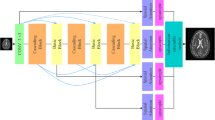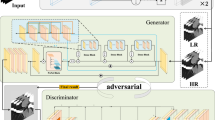Abstract
Super-resolution (SR) in medical imaging is an emerging application in medical imaging due to the needs of high quality images acquired with limited radiation dose, such as low dose Computer Tomography (CT), low field magnetic resonance imaging (MRI). However, because of its complexity and higher visual requirements of medical images, SR is still a challenging task in medical imaging. In this study, we developed a deep learning based method called Medical Images SR using Generative Adversarial Networks (MedSRGAN) for SR in medical imaging. A novel convolutional neural network, Residual Whole Map Attention Network (RWMAN) was developed as the generator network for our MedSRGAN in extracting the useful information through different channels, as well as paying more attention on meaningful regions. In addition, a weighted sum of content loss, adversarial loss, and adversarial feature loss were fused to form a multi-task loss function during the MedSRGAN training. 242 thoracic CT scans and 110 brain MRI scans were collected for training and evaluation of MedSRGAN. The results showed that MedSRGAN not only preserves more texture details but also generates more realistic patterns on reconstructed SR images. A mean opinion score (MOS) test on CT slices scored by five experienced radiologists demonstrates the efficiency of our methods.










Similar content being viewed by others
References
K Armanious, C Jiang, M Fischer, T Küstner, K Nikolaou, S Gatidis, B Yang 2018. “MedGAN: Medical Image Translation using GANs”. In: arXiv:1806.06397 [cs.CV]
Berrington GA, Kim KP, Berg CD (2008) Low-dose lung CT screening before age 55: estimates of the mortality reduction required to outweigh the radiation-induced cancer risk. In: J Med Screen 15(3):153–158. https://doi.org/10.1258/jms.2008.008052
Chen Y, Xie Y, Zhou Z, Shi F, Christodoulou AG, Li D (2018) Brain MRI super resolution using 3D deep densely connected neural networks. In: In: 2018 IEEE 15th international symposium on biomedical imaging (ISBI 2018), Washington, pp 739–742
Y Chen, F Shi, A G Christodoulou, Y Xie, Z Zhou, D Li 2018. “Efficient and Accurate MRI Super-Resolution Using a Generative Adversarial Network and 3D Multi-level Densely Connected Network”. In: Frangi A., Schnabel J., Davatzikos C., Alberola-López C., Fichtinger G. (eds) Medical Image Computing and Computer Assisted Intervention - MICCAI. MICCAI 2018. Lecture notes in computer science, vol 11070. Springer, Cham
Z Cheng, Y Ding, X He, L Zhu, X Song, M Kankanhalli 2018. “A3NCF: an adaptive aspect attention model for rating prediction”. In: IJCAI'18 Proceedings of the 27th International Joint Conference on Artificial Intelligence, pp. 3748–3754, July
K Cho et al. 2014 “Learning phrase representations using RNN encoder-decoder for statistical machine translation”. In: arXiv:1406.1078 [cs.CL]
Christe A, Torrente JC, Lin M, Yen A, Hallett R, Roychoudhury K, Schmitzberger F, Vock P, Roos J (2011) CT screening and follow-up of lung nodules: Effects of tube current-time setting and nodule size and density on detectability and of tube current-time setting on apparent size. AJR am J Roentgenol 197(3):623–630. https://doi.org/10.2214/AJR.10.5288
C Dong, C C Loy, K He, X Tang 2014. “Learning a Deep Convolutional Network for Image Super-Resolution”. In: Fleet D., Pajdla T., Schiele B., Tuytelaars T. (eds) Computer Vision – ECCV 2014. ECCV 2014. Lecture notes in computer science, vol 8692. Springer, Cham
Gatys LA, Ecker AS, Bethge M (2016) Image Style Transfer Using Convolutional Neural Networks. In: IEEE conference on computer vision and pattern recognition (CVPR), vol 2016, Las Vegas, pp 2414–2423
Gondara L (2016) Medical Image Denoising Using Convolutional Denoising Autoencoders. In: IEEE 16th international conference on data mining workshops (ICDMW), vol 2016, Barcelona, pp 241–246
I Goodfellow, J Pouget-Abadie, M Mirza, B Xu, D Warde-Farley, S Ozair, A Courville, Y Bengio 2014. “Generative Adversarial Nets”. In: Z. Ghahramani and M. Welling and C. Cortes and N. D. Lawrence and K. Q. Weinberger (eds) Advances in Neural Information Processing Systems 27, , Curran associates, Inc pp 2672–2680.
Greenspan H (2008) Super-resolution in medical imaging. In: Comput J 52(1):43–63
Guo Y, Cheng Z, Nie L, Wang Y, Ma J, Kankanhalli M (2019) Attentive Long Short-Term Preference Modeling for Personalized Product Search. ACM Transactions on Information Systems (TOIS) 37(2). https://doi.org/10.1145/3295822
He K, Zhang X, Ren S, Sun J (2016) Deep Residual Learning for Image Recognition. In: IEEE conference on computer vision and pattern recognition (CVPR), vol 2016, Las Vegas, pp 770–778
J Hu, L Shen, G Sun n.d.. “Squeeze-and-excitation networks”. In: IEEE Transactions on Pattern Analysis and Machine Intelligence
Huang G, Liu Z, Maaten LVD, Weinberger KQ (2017) Densely Connected Convolutional Networks. In: IEEE conference on computer vision and pattern recognition (CVPR), vol 2017, Honolulu, pp 2261–2269
Hunink MGM, Gazelle GS (2003) CT screening: A trade-off of risks, benefits, and costs. the journal of clinical investigation 111(11):1612–1619. https://doi.org/10.1172/JCI200318842
Isola P, Zhu J, Zhou T, Efros AA (2017) Image-to-Image Translation with Conditional Adversarial Networks. In: IEEE conference on computer vision and pattern recognition (CVPR), vol 2017, Honolulu, pp 5967–5976
G Jiang, Y Lu, J Wei, Y Xu 2019. “Synthesize mammogram from digital breast tomosynthesis with gradient guided cGANs”. In: Shen D. et al. (eds) Medical Image Computing and Computer Assisted Intervention – MICCAI. MICCAI 2019. Lecture notes in computer science, vol 11769. Springer, Cham.
Jifara W, Jiang F, Rho S, Cheng M, Liu S (2019) Medical image denoising using convolutional neural network: a residual learning approach. In: J Supercomput 75:704–718. https://doi.org/10.1007/s11227-017-2080-0
Y Jing, Y Yang, Z Feng, J Ye, Y Yu, M Song 2017. “Neural Style Transfer: A Review”. In: arXiv:1705.04058 [cs.CV]
J Johnson, A Alahi, Fei-Fei Li 2016 “Perceptual Losses for Real-Time Style Transfer and Super-Resolution”. In: Leibe B., Matas J., Sebe N., Welling M. (eds) Computer Vision – ECCV. ECCV 2016. Lecture notes in computer science, vol 9906. Springer, Cham.
A Jolicoeur-Martineau 2018. “The relativistic discriminator: a key element missing from standard GAN”. In: arXiv:1807.00734 [cs.LG]
Karadi RL (2006) Radiation risk of screening with low dose CT. Thorax 61(6):548
Kavanagh J, Liu G, Menezes R, O’Kane GM, McGregor M, Tsao M, Shepherd FA, Schmidt H (2018) Importance of Long-term Low-Dose CT Follow-up after Negative Findings at Previous Lung Cancer Screening. Radiology 289(1). https://doi.org/10.1148/radiol.2018180053
Kim J, Lee JK, Lee KM (2016) Deeply-Recursive Convolutional Network for Image Super-Resolution. In: IEEE conference on computer vision and pattern recognition (CVPR), vol 2016, Las Vegas, pp 1637–1645
Kim J, Lee JK, Lee KM (2016) Accurate Image Super-Resolution Using Very Deep Convolutional Networks. In: IEEE conference on computer vision and pattern recognition (CVPR), vol 2016, Las Vegas, pp 1646–1654
D P Kingma, J Ba 2014. “Adam: A method for stochastic optimization”. In: arXiv:1412.6980 [cs.LG]
D Kouame, M Ploquin 2009. “Super-resolution in medical imaging: an illustrative approach through ultrasound”. In: IEEE International Symposium on Biomedical Imaging pp 249-252
Ledig C et al (2017) Photo-Realistic Single Image Super-Resolution Using a Generative Adversarial Network. In: IEEE conference on computer vision and pattern recognition (CVPR), vol 2017, Honolulu, pp 105–114
D Lee, J Yoo, J C Ye 2017 “Compressed sensing and parallel MRI using deep residual learning”. In: Proc. 25st Annu. Meeting ISMRM
Libby DM, Wu N, Lee IJ, Farooqi A, Smith JP, Pasmantier MW, McCauley D, Yankelevitz DF, Henschke CI (2006) CT screening for lung cancer: The value of short-term CT follow-up. chest 129(4):1039–1042
Lim B, Son S, Kim H, Nah S, Lee KM (2017) Enhanced Deep Residual Networks for Single Image Super-Resolution. In: IEEE conference on computer vision and pattern recognition workshops (CVPRW), vol 2017, Honolulu, pp 1132–1140
Lingala SG, Hu Y, DiBella E, Jacob M (2011) Accelerated dynamic MRI exploiting sparsity and low-rank structure: k-t SLR. In: IEEE Transactions on Medical Imaging 30(5):1042–1054
Mardani M et al (2019) Deep generative adversarial neural networks for compressive sensing MRI. IEEE Transactions on Medical Imaging 38(1):167–179
M Mirza, S Osindero 2014. “Conditional Generative Adversarial Nets”. In: arXiv:1411.1784 [cs.LG]
Mohammed RH, Sabry YY, Nasef AA (2011) Brain MRI screening showing evidences of early central nervous system involvement in patients with systemic sclerosis. Rheumatol Int. 31(5):667–671. https://doi.org/10.1007/s00296-009-1325-5
Rampinelli C, Origgi D, Bellomi M (2013) Low-dose CT: technique, reading methods and image interpretation. Cancer Imaging 12:548–556. https://doi.org/10.1102/1470-7330.2012.0049
Ravishankar S, Bresler Y (2011) MR image reconstruction from highly undersampled k-space data by dictionary learning. In: IEEE Transactions on Medical Imaging 30(5):1028–1041
Setio AAA, Traverso A, de Bel T, Berens MSN, Bogaard C, Cerello P, Chen H, Dou Q, Fantacci ME, Geurts B, Gugten R, Heng PA, Jansen B, de Kaste MMJ, Kotov V, Lin JYH, Manders JTMC, Sóñora-Mengana A, García-Naranjo JC, Papavasileiou E, Prokop M, Saletta M, Schaefer-Prokop CM, Scholten ET, Scholten L, Snoeren MM, Torres EL, Vandemeulebroucke J, Walasek N, Zuidhof GCA, Ginneken B, Jacobs C (2017) Validation, comparison, and combination of algorithms for automatic detection of pulmonary nodules in computed tomography images: the LUNA16 challenge. Med Image Anal 42:1–13. https://doi.org/10.1016/j.media.2017.06.015
Shi W et al (2016) Real-Time Single Image and Video Super-Resolution Using an Efficient Sub-Pixel Convolutional Neural Network. In: IEEE conference on computer vision and pattern recognition (CVPR), vol 2016, Las Vegas, pp 1874–1883
K Simonyan, A Zisserman. 2014 “Very Deep Convolutional Networks for Large-Scale Image Recognition”. In: arXiv:1409.1556 [cs.CV]
Ulus S, Suleyman E, Ozcan UA, Karaarslan E (2016) Whole-Body MRI Screening in Asymptomatic Subjects; Preliminary Experience and Long-Term Follow-Up Findings. Polish Journal of Radiology 81:407–414. https://doi.org/10.12659/PJR.897570
Wang F et al (2017) Residual Attention Network for Image Classification. In: IEEE conference on computer vision and pattern recognition (CVPR), vol 2017, Honolulu, pp 6450–6458
X Wang et al. 2018 “ESRGAN: Enhanced Super-Resolution Generative Adversarial Networks”. In: Leal-Taixé L., Roth S. (eds) Computer Vision – ECCV Workshops. ECCV 2018. Lecture notes in computer science, vol 11133. Springer, Cham
S Woo, J Park, J Y Lee, I S Kweon 2018. “CBAM: Convolutional Block Attention Module”. In: Ferrari V., Hebert M., Sminchisescu C., Weiss Y. (eds) Computer Vision – ECCV 2018. ECCV. Lecture notes in computer science, vol 11211. Springer, Cham.
Yasuda S, Ide M (2005) PET and cancer screening. Annals of nuclear medicine 19(3):167–177
C You et al. 2018 “CT Super-resolution GAN Constrained by the Identical, Residual, and Cycle Learning Ensemble(GAN-CIRCLE)”. In: arXiv:1808.04256 [eess.IV]
Y Zhang, K Li, K Li, L Wang, B Zhong, Y Fu 2018. “Image Super-Resolution Using Very Deep Residual Channel Attention Networks”. In: Ferrari V., Hebert M., Sminchisescu C., Weiss Y. (eds) Computer Vision – ECCV 2018. ECCV 2018. Lecture notes in computer science, vol 11211. Springer, Cham
Zhu J, Park T, Isola P, Efros AA (2017) Unpaired Image-to-Image Translation using Cycle-Consistent Adversarial Networks. In: 2017 IEEE International Conference on Computer Vision (ICCV), Venice, pp 2242–2251
Acknowledgments
This work was supported in part by the National Key R&D Program of China under Grant 2018YFC1704206, Grant 2016YFB0200602, in part by the NSFC under Grant 81971691, Grant 81801809, Grant 81830052, Grant 81827802, Grant U1811461, and Grant 11401601, in part by the Science and Technology Program of Guangzhou under Grant 20180420053, in part by the Science and Technology Innovative Project of Guangdong Province under Grant 2016B030307003, Grant 2015B010110003, and Grant 2015B020233008, in part by the Science and Technology Planning Project of Guangdong Province under Key Grant 2017B020210001, in part by the Guangzhou Science and Technology Creative Project under Key Grant 201604020003, in part by the Guangdong Province Key Laboratory of Computational Science Open Grant 2018009, in part by the Construction Project of Shanghai Key Laboratory of Molecular Imaging 18DZ2260400, and in part by China postdoctoral science foundation No.2019M653185.
Author information
Authors and Affiliations
Corresponding authors
Additional information
Publisher’s note
Springer Nature remains neutral with regard to jurisdictional claims in published maps and institutional affiliations.
Rights and permissions
About this article
Cite this article
Gu, Y., Zeng, Z., Chen, H. et al. MedSRGAN: medical images super-resolution using generative adversarial networks. Multimed Tools Appl 79, 21815–21840 (2020). https://doi.org/10.1007/s11042-020-08980-w
Received:
Revised:
Accepted:
Published:
Issue Date:
DOI: https://doi.org/10.1007/s11042-020-08980-w




